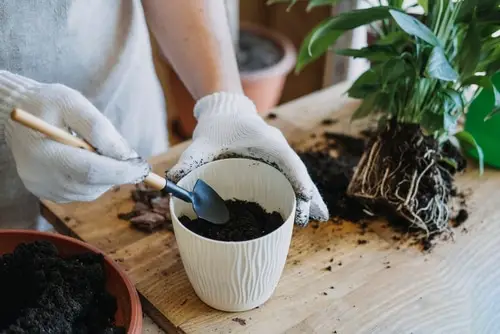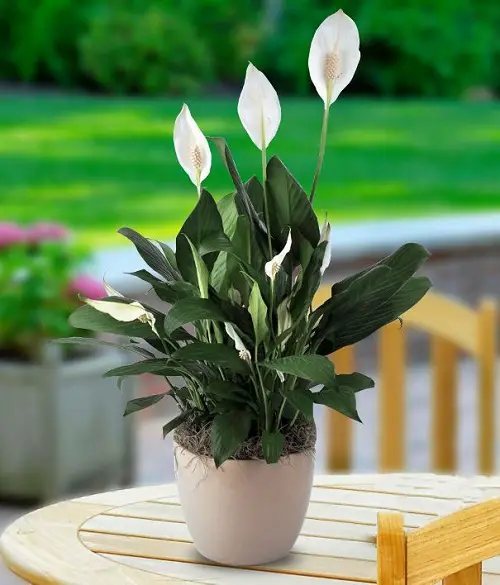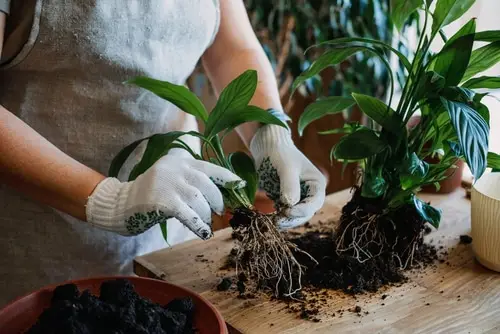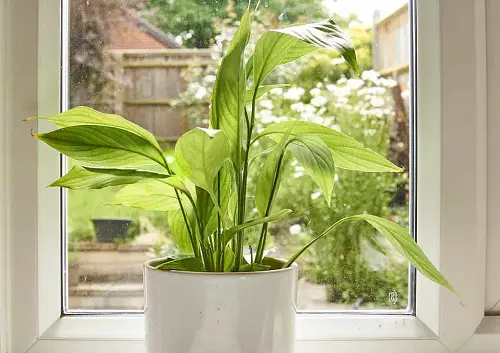Learn How to Fix and Save Overwatered Peace Lily with proper care and attention. It will help you keep the plant at the top of its health.
It is a well-known fact that overwatering can be extremely detrimental to the health of your Peace Lily. This is because excess moisture can lead to a serious condition known as root rot, which can ultimately prove fatal to the plant. Nevertheless, there are steps you can take to save your plant, even if it has already contracted this disease.
To help you through this process, we have created a step-by-step guide on How to Fix and Save Overwatered Peace Lily.
Follow Best Peace Lily Care Tips + How to Grow Spathiphyllum Indoors
How Do You Know If Your Peace Lily Is Overwatered?
- When a Peace Lily is overwatered, it initially displays symptoms such as drooping leaves that gradually turn pale and yellow.
- If the plant remains in this state for an extended period, it can lead to leaf edema, causing the leaf tips to turn brown and develop water blisters, and the plant may stop growing altogether.
- The leaves will eventually wither, and the roots may become soft and rotten.
Nevertheless, it is often possible to rescue the plant by following a systematic approach to recovery, which involves repotting, proper plant care, and appropriate watering practices.
Find out Why My Peace Lily is Drooping, Turning Yellow, Not Flowering, and Dying
Symptoms of Overwatering In Peace Lily
Properly watering a Peace Lily can be challenging. If the plant is underwatered, its leaves may become limp, curl up, and droop. Conversely, overwatering the plant can also lead to undesirable symptoms.
- The initial signs of overwatering may be mild and may go unnoticed, but one can look for yellow leaves at the plant’s bottom. The yellowing usually starts at the edges of the leaves and gradually spreads.
- If the plant is consistently overwatered for a significant period, it may develop leaf edema, which appears as small water cysts on the leaves.
- Gradually, the leaf tips may turn brown, and fungal or bacterial infections may cause yellow spots to form on the leaves.
- The plant’s growth may become stunted, with no new leaves emerging and old ones wilting and falling off.
- As the damp conditions persist, the plant may become susceptible to root rot. The roots may weaken, become mushy, turn black, and emit a foul odor.
Find out How to Propagate Peace Lily
Elements That Contribute To the Signs of Overwatering

Overwatering may not necessarily be caused solely by watering the plant more frequently than needed. While this is the primary cause, there are other contributing factors that can lead to the development of overwatering symptoms in the plant.
1. Container Material
Terracotta pots are the best due to their porous nature, which allows water to drain out easily, preventing the soil from becoming too damp.
On the other hand, non-porous materials such as plastic and ceramic should be avoided as they tend to retain water for longer periods of time.
2. Size of the Container
Selecting the appropriate pot size for your plant is essential. If a small plant is placed in a pot that is too large, it may take longer for the soil to dry out and lose moisture, which can cause concerns for your Peace Lily plant as it prefers well-draining soil and can be susceptible to issues caused by overly wet or soggy conditions.
3. Temperature, Humidity, and Wind
The rate at which roots absorb water is closely tied to the process of transpiration, which is the evaporation of moisture from the above-ground parts of leaves.
Transpiration appears at a higher rate in hotter seasons when humidity levels are low, and it can be further increased by wind, which enhances evaporation.
As transpiration occurs, the roots absorb more water, leading to quicker soil drying. In contrast, during colder seasons, lower rates of transpiration can limit the uptake of water by roots, causing the soil to remain mostly wet.
Discover Best Places to Keep a Peace Lily in the House
How to Fix and Save An Overwatered Peace Lily
1. Re-potting
Allowing a waterlogged plant to recover on its own by waiting for the gradual evaporation of excess water from its soaked soil is risky, as it may contract rot and infections.
Time is critical, and the longer the plant remains in wet soil, the harder it becomes to revive it.
- The first step in this situation is to remove the plant from the waterlogged soil and transplant it into a well-draining soil mix.
- If the plant has root rot, it’s essential to transplant it into a new sterilized pot. Using the same pot can cause reinfection.
- It’s important to select an appropriately sized pot to avoid water accumulation. The soil mix in a new packet is usually moist, so it’s unnecessary to water the plant immediately after repotting.
- Wait for the roots to absorb the moisture before moving on to the next step.
2. Make a Watering Schedule
To ensure a Peace Lily plant’s healthy growth, watering it carefully is crucial. It’s essential to maintain a delicate balance between providing enough water and not leaving it completely dry.
It’s best not to rely on the misleading signs of the plant and instead use your hand to feel the soil mix. Insert two fingers into the soil and evaluate whether it requires watering. If the soil is entirely dry, it’s time to water your Peace Lily plant.
3. Skip Fertilization
Fertilizing a waterlogged plant that is already struggling can be more harmful than helpful due to the added mineral salts. After repotting, it’s best to avoid fertilizers for at least three months.
Only when the plant has fully recovered and its roots and leaves appear healthy should you consider using fertilizers. During the growing season, it’s recommended to fertilize your plant only once a month using a balanced feed.
4. Maintain Proper Humidity Levels
Peace Lilies naturally flourish in humid tropical environments. However, their growth may be impacted when kept indoors or in gardens where the air is dry and harsh.
To prevent this, misting the plant occasionally during the hot season can be helpful. Additionally, surrounding the plant with trays of wet pebbles can also increase the humidity levels in its surroundings through water evaporation.
5. Provide Sufficient Sunlight
Adequate sunlight exposure is important for the healthy growth and development of your plant as it promotes photosynthesis. However, Peace Lilies are sensitive to excessive direct sunlight.
It is recommended to place the pot in a shaded area where the plant receives a sufficient amount of indirect sunlight. Direct sunlight can be even more detrimental to weakened plants in recovery, as it can scorch and kill the leaves.
Pro Tip: Keep the plant in the mild morning sun for 2-3 hours daily.
6. Keep the Plant at the Perfect Temperature
Due to their inability to tolerate cold temperatures below 40 F(4 C), Peace Lilies are commonly grown as houseplants.
For a speedy recovery, it’s recommended to keep your plant in an environment where the temperature falls within the ideal range of 65 to 80 F (18-27 C).





